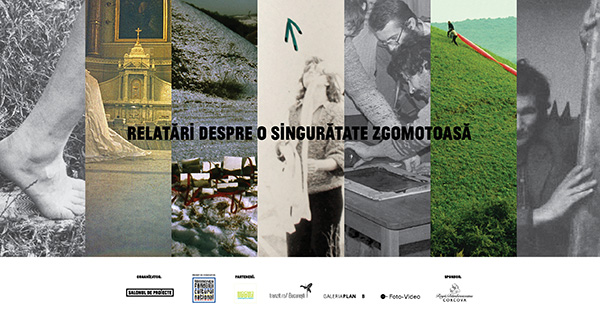ACCOUNTS OF TOO LOUD A SOLITUDE
25.04.2024 - 09.06.2024
Artists: Alexandru Antik, Imre Baász, Rudolf Bone, Ioan Bunuș, Károly Elekes, Károly Ferenczi, Aladár Garda, Dorel Găină, Anikó Gerendi, György Jovián, Gyöngyi Kerekes Ujvárossy, Karoy Kovács, Sándor Krizbai, Árpád Nagy, Miklós Onucsán, Dan Perjovschi, Radu Procopovici, Decebal Scriba, Zoltán Szabó, Gábor Szörtsey, László Ujvárossy
Curator: Mădălina Brașoveanu
Opening: Thursday, April 25, 19.00
The current exhibition starts from the research underlying the book Too Loud a Solitude. Unconventional Artistic Practices at Atelier 35 Oradea and MAMŰ Group in Târgu-Mureș, 1978-1989 (2022) and presents a selection of artworks and documentation on unconventional exhibitions, actions, and episodes that made up the activity of some of the artists who were members of the art collectives in the two centers. Aiming to reflect the diversity of their practice and the pursuit of these artists to innovate the visual language departing from the traditional media – in a predominantly conformist and conservative social and professional environment, a climate that was to some degree infused with the official ideology of the times –, the exhibition presents the variety of physical, social, and conceptual spaces created by the artists through their interventions and experiments. From the institutional space to the street, the workplace, the home, the artist’s studio, the natural environment, and the postal correspondence up to the “top secret” space from where the political police was conducting its close surveillance, they were all intersected, inhabited, and marked by the artists’ actions, in various degrees of visibility and with various intensities. None of these spaces was clearly delimited, their boundaries dissolving into each other’s to make a vast area of maneuver, negotiations, and adaptations, where art was happening and the limits that confined its territory were being questioned and contested.
Bohumil Hrabal’s book Too Loud a Solitude suggested analogies with some of the recurrent motifs outlined during the research. The Hanta character, engaged in the machinery of standardized and planned production from a marginal role, acting in a subterranean yet visible place that belonged to a state-owned company, strongly resonated with some personal and collective artistic biographies. Hanta’s packages – those many archives that indiscriminately put together rare and precious books with paper waste of various origins, which he often wrapped in reproductions of old-masters’ artworks – resonated with the studio collections I was studying. Archives not of what the regime of the time chose to record and officially state about itself, but of what was being discarded and destroyed in the name of progress, to be reused, recycled – and therefore, endowed with new ideas, norms, and values –, Hanta’s packages reflect the complex conflict derived from the multiple management of the archive / memory. A conflict that now comes out from confronting the self-historicization / self-archiving with the officialized versions of the same past and which continues to inform the way in which the recent history of local art is being canonized.
The artists’ personal archives and the oral history – in other words, what was possible to recuperate from “Hanta’s packages” – constituted the main documentation sources of the research, a fact that is reflected in the exhibition in the syncopes, the frailty and (sometimes) the distortions they bring along, as sole keepers of a consistent segment of the recent history of local art. The weight these archives carry in the research of the history of local art in general points out the ever-increasing urgency to access, recuperate, and save them, as much as possible, from a very likely disappearance, together with the generations of artists that created them during their too loud a solitude. (Mădălina Brașoveanu)
Images (from left to right): details of László Ujvárossy, The Step (or The Journey), 1983; Miklós Onucsán, Accidental Installation, 1981; Károly Elekes, White Knoll, Memory of the Knoll, 1984; Grupul MAMŰ, Action on the 1st of May, 1979; Sándor Krizbai, Multiplication in Art, 1981; Grupul MAMŰ and The Young Artist's Studio from Budapest, The Big Sausage, 1981; Ioan Bunuș, The Drawing Action, 1982
This exhibition is organised by Salonul de proiecte Association, as a part of the project ”Accounts of Too Loud a Solitude.”
Translations: Bertha Savu
Graphic design: Larisa Sitar
Production: Robert Băjenaru
Special thanks: The Institute of the Present
Partners: MAGMA Contemporary Medium; tranzit.ro/ București; Galeria Plan B; Departamentul Foto-Video, UNArte București
Sponsor: Corcova Roy & Dâmboviceanu
Cultural project co-funded by the Administration of the National Cultural Fund
The project does not necessarily represent the position of the Administration of the National Cultural Fund. The AFCN is not responsible for the content of the project or the manner in which the results of the project may be used. These are entirely the responsibility of the funding recipient.



